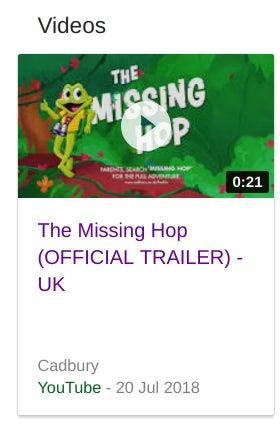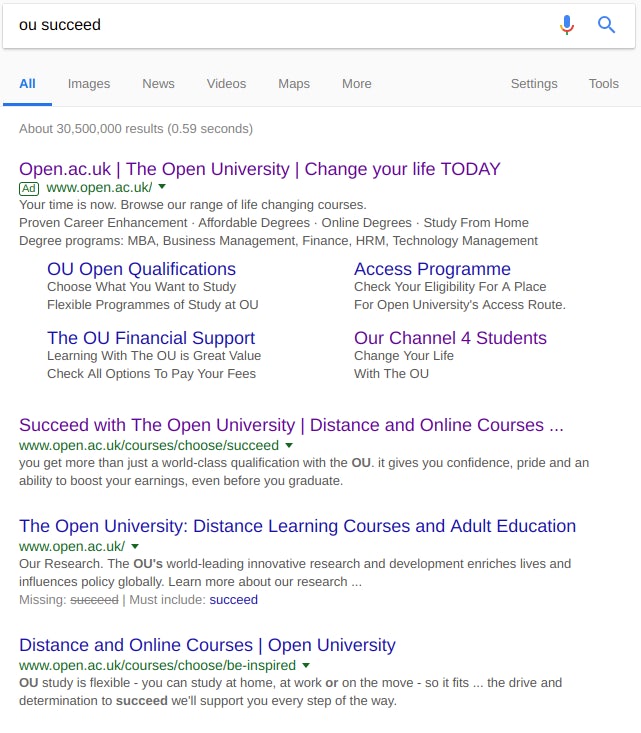It’s a Tuesday evening. I’m settling down in the cinema to watch Mamma Mia: Here We Go Again (a glorious film). The lights dim; the adverts begin.
First up is a local advert from Rutland Cycles, promoting their new Nottingham store. The ad finishes with a simple call to action (CTA): “search for rutland cycling nottingham.”
The local ads finish and next up are the standard ads. The second or third is an advert for the Open University. It rolls through the standard spiel, then finishes with this CTA: “search ou succeed.”
Fast forward through 2 hours of Abba songs, flared trousers and a night dreaming of sunny Greek islands and I’m walking to work. The sun is shining. Out of the corner of my eye I spot a flash of purple. I glance over, and there on the side of a bus shelter is a Cadbury Freddo ad. In many ways, it’s a standard advert, except its CTA reads “search missing hop.”
These CTAs that give viewers specific searches to follow up with are not new – they’ve been around for a while. But it feels like more and more are popping up all of a sudden. Seeing these three in the space of a couple of days got me thinking about how these ads are integrating offline and online marketing techniques. In the rest of this blog post, I’ll look at each of these adverts to break down what they’re doing, before wrapping up with an overview of risks and benefits to help you think about whether it’s a tactic your business could benefit from.
Cadbury – Missing Hop
Of my three adverts, Cadbury’s is the only one that doesn’t focus on a brand term. It’s also unique in that the campaign incorporates a YouTube video, as well as the campaign’s main Freddo landing page (please note that the campaign’s page is no longer available, as it was removed when this particular campaign finished).
In encouraging users to search for [missing hop], Cadbury has chosen a search term that is memorable and that they will have no competition for. Both are key for this technique to be a success. To include a search in their ads, businesses have to be 100% certain that they will rank top for it and that customers will remember the exact phrase or a close enough variant that they will always find the right page.
Cadbury hasn’t actually done a lot to ensure that their Freddo page is optimised for the search term. It appears that the fact that no one else is trying to rank for it is enough to ensure that they get the number 1 spot. Their search presence is helped by the high ranking of their YouTube video in Google’s video cards. All in all, their search presence is not as well optimised as the other campaigns that we’ll see.

The website highlights another big advantage of this tactic that we’ll see with both of the other examples. It lets users navigate to the page that Cadbury wants them to land on. They have tailored their Freddo page to tie in with the missing hop campaign, adding a big banner and downloadable resources. The point of the page doesn’t appear to be to sell Freddos directly, but to make the brand more prominent.
However, I can’t help but feel that Cadbury could have made more of this opportunity. There isn’t a lot of content on this page and it’s not clear from the advert itself who the target audience is or what the campaign is actually trying to achieve. The requirement to fill out a full form before you can enter is also an unnecessary stumbling block, given that there’s no real reason to put an age restriction on the content of the page.
Key points
- Low-risk search term
- Ranking with a YouTube video and the Freddo page
- Lack of focus in the page’s content
The Open University – OU Success
This second campaign is the one that I personally feel has been executed the most successfully. Of course, I don’t have access to conversion data to back that claim up, but it looks like the Open University has got a lot of things right.
At the heart of the campaign is a search term that’s easy to remember – [ou succeed] – with a specific landing page ranking top: http://www.open.ac.uk/courses/choose/succeed. In fact, it looks like the OU has nailed the SERP:

At the top of the SERP is an OU ad, featuring a range of ad extensions including sitelinks, a callout extension and a structured snippet. This allows them to pack a lot of information into one place and give some specific options to searchers.
At the top of the organic results we have the campaign-specific page, ranking first as it should. The only thing that lets it down is the lack of optimisation in the metadata, with a truncated title tag and a description with odd capitalisation.
Below this result is their homepage and a main course page, both of which could be useful to searchers who want to find more information.
The page itself is useful without being spectacular. It opens with a CTA for a prospectus, then gives more information and links to the courses, followed by USPs and links to more information. While the user journey might not be as clear as it was in Cadbury’s campaign, the Open University is selling something different. Most people will want to find out more rather than immediately signing up for a course, so they’ve done a very good job of making further information accessible.
Key points
- Memorable, branded search term
- Great use of PPC to get more information into the SERPs
- Metadata needs further optimisation
- Useful landing page that meets user intent
Rutland Cycling – Nottingham campaign
Our final campaign is different in that it’s designed to promote a new physical location as opposed to a competition or a general visibility boost. That is reflected in the search term they’ve chosen, [rutland cycling nottingham] which is a simple combination of the brand name and the new location. It is the riskiest of the three search terms, but the presence of the Rutland Cycling Knowledge Graph shows that the brand is strong enough to secure the organic visibility.
The company has arguably made even better use of paid ads than the Open University, advertising a sale rather than the brand alone. They’ve included user reviews and a location extension to ad credibility. The overall effect is that the ad gives users another incentive to visit the brand, adding low prices to curiosity.

While the landing page itself – https://www.rutlandcycling.com/pages/rutland-cycling-specialized-concept-store-nottingham.aspx – is more sparse than the others we’ve seen, it has clearly been designed to encourage people to visit the store. All the information you need, including location, opening hours and contact details, are readily available to the right of a map. Further down the page is more information about the company, their stock and their other stores: everything you would need to learn about them if this was your first time looking them up.
Key points
- Search term with a heavy brand presence
- Good use of paid advertising to highlight the sale
- Landing page provides all the information you need to visit the store
Risks and benefits
I can see why this combination of search and offline marketing has become popular. Search terms are much easier to remember than URLs and give companies the freedom to make a full landing page for the campaign. By using SEO and PPC together, these businesses can completely control their SERP and give customers as many reasons as possible to convert.
Another benefit is that it makes offline campaigns more measurable. You can track traffic to the page to see how effective the adverts are being, given that it’s fairly safe to attribute all organic landings to people who have seen the ads. This makes it much easier to demonstrate a return on investment and to benchmark future campaigns.
On the other hand, successfully executing a campaign like this takes careful research. You need to find a search term that is both memorable and completely lacking competition, or you run the risks of people either forgetting it or landing on someone else’s website. The landing pages need to be well optimised and should be carefully designed with the target user in mind; if the user doesn’t have a good experience the first time they visit it’s unlikely that they’ll return to convert in the future.
Another factor to weigh up is the difficulty of the offline campaign itself. The things we’ve talked about are expensive and tend to work better for more recognisable brands that have a big budget to spend. Even Rutland Cycling, though they used local advertising, are a big enough brand that they can put the budget they need into the campaign. If one of these campaigns was to flop, a lot of money and time would have been wasted in getting the ads seen and in creating the web pages to back them up.
Taking all that into consideration, it’s clear that succeeding with this interesting strategy takes careful planning. It will involve assessing finances and potential ROI, identifying the target audience and designing ads and web pages that meet their needs. But, with experience, time and money, the search tactic seems like a great way to give an offline campaign a boost. Anything that makes offline channels more measurable and easier for viewers to act on is an improvement.
Have you seen any examples of campaigns like this that you like? Or campaigns that don’t seem so good? Let us know in the comments!



